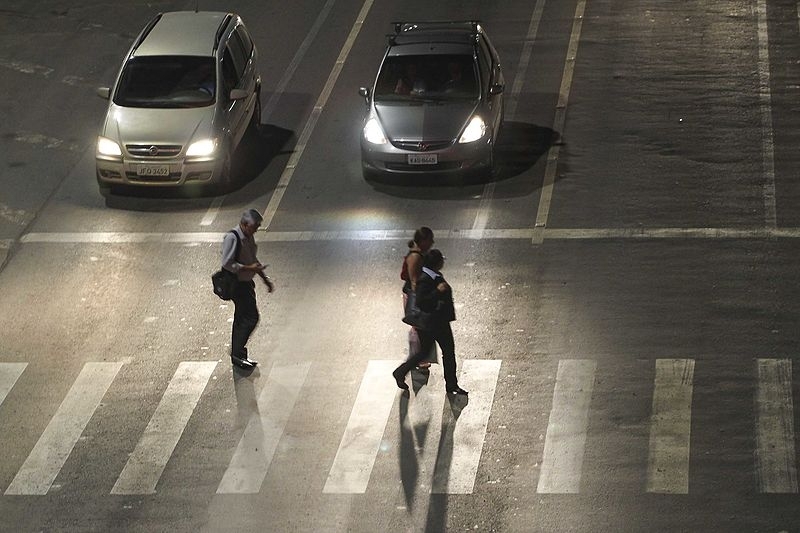

A study shows that simple changes would guarantee mobility and autonomy for the growing population of seniors in São Paulo City, Brazil (photo: Wikimedia Commons)
A study shows that simple changes would guarantee mobility and autonomy for the growing population of seniors in São Paulo City, Brazil.
A study shows that simple changes would guarantee mobility and autonomy for the growing population of seniors in São Paulo City, Brazil.

A study shows that simple changes would guarantee mobility and autonomy for the growing population of seniors in São Paulo City, Brazil (photo: Wikimedia Commons)
By Maria Fernanda Ziegler | Agência FAPESP – The sidewalks are only a few meters apart, but crossing the street can be a challenge, especially for the over-sixties. Too often, the walk signal goes from green to red before they can safely reach the other side.
A study conducted by the University of São Paulo’s Public Health School (FSP-USP) in Brazil found that 97.8% of older people in São Paulo City cannot walk at 4.3 kilometers per hour (km/h), the speed required by the timing of the traffic lights operated by the Traffic Engineering Company (CET-SP). Volunteers older than 60 years of age who participated in the study were able to walk at an average of only 2.7 km/h.
To measure the walking speed of the 1,191 older participants, the researchers resorted to the infrastructure of the Survey on Health, Wellbeing & Aging – SABE in the Portuguese acronym – a multi-cohort cross-sectional study on the living conditions and health of the elderly in São Paulo.
This multi-centric survey was initiated at the regional level by the Pan American Health Organization (PAHO) in 2000. It covered seven major cities in Latin America and the Caribbean, including São Paulo. With FAPESP’s support, it was re-run in São Paulo in 2006, 2010 and 2016.
“The walking speed required to cross a city street is unsafe or actually unattainable for older people in São Paulo and in cities throughout Brazil,” said Etienne Duim, co-author of an article on the results of the study that was published in the Journal of Transport & Health. The other co-authors were José Leopoldo Ferreira Antunes and Maria Lucia Lebrão (who died in July 2016).
According to data from SEADE, the São Paulo State bureau of statistics, over-sixties accounted for 12.74% of the state capital’s population in 2016.
“What we found from the study is that the city isn’t managed for older people but for adult individuals who can walk between 4 km/h and 6 km/h without much difficulty, at least for a while. The effect is that older people tend more and more to stay at home,” said Antunes, Full Professor at FSP-USP and coordinator of the survey.
Data for August 2016 were supplied by CET-SP, which regulates traffic signal timing using a formula that assumes a speed of 4.3 km/h for pedestrians who cross the street while the walk signal is green. The study excluded the time during which the signal is flashing red. According to CET-SP, no changes have been made to traffic signal timing since the survey. A review of the literature conducted by the researchers showed that cities such as Valencia and Barcelona in Spain have reduced the necessary speed to 3.2 km/h.
According to Duim, a study performed in the United Kingdom produced findings very similar to São Paulo’s. “The UK survey actually influenced the country’s traffic regulations, which extended pedestrian crossing time,” he said.
Both studies conclude that for older people, walking has an important relationship to health and social interaction, and factors that hinder their mobility, such as the difficulty of crossing the street, can lead to a loss of autonomy and deteriorating quality of life.
No hurry
Duim suggests that São Paulo make changes similar to those made in the UK and Spain. This would ensure autonomy and mobility for older people and most importantly would reduce the risk of traffic accidents involving pedestrians.
“Would an increase of 5 seconds in pedestrian crossing time have an impact on traffic? Perhaps,” he said. “However, surveys conducted in other countries suggest this change could be diluted by other measures, such as changing the speed limit for vehicles and incentives to use public transport, for example.”
For Duim, an interesting option for São Paulo would be the project implemented in Curitiba, the capital city of Paraná State, where there are now a number of smart traffic lights in which an older person can insert a card to “tell” the system more time is required to cross the street.
“The same goes for people in wheelchairs and others with mobility difficulties, such as pregnant women and adults with small children, for example,” he said. “It’s a solution that doesn’t really affect traffic and creates a valid process of social inclusion.”
The article “Walking speed of older people and pedestrian crossing time” (doi: http://dx.doi.org/10.1016/j.jth.2017.02.001) by Etienne Duim, Maria Lucia Lebrão and José Leopoldo Ferreira Antunes can be retrieved from sciencedirect.com/science/article/pii/S2214140516302250.
Read more about the SABE survey in Portuguese:
Idade compromete sistema imune e reduz eficácia de vacinas
In English:
Population aging should be a priority for public policy
Republish
The Agency FAPESP licenses news via Creative Commons (CC-BY-NC-ND) so that they can be republished free of charge and in a simple way by other digital or printed vehicles. Agência FAPESP must be credited as the source of the content being republished and the name of the reporter (if any) must be attributed. Using the HMTL button below allows compliance with these rules, detailed in Digital Republishing Policy FAPESP.





